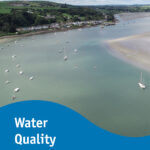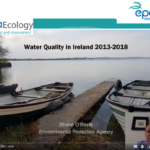June 13, 2023: The Environmental Protection Agency (EPA) has published…
EPA publishes Water quality monitoring report on nitrogen and phosphorous concentrations in Irish waters 2023
This report provides an update on the results of water quality monitoring to support the assessment of the impact of the nitrate’s derogation on Irish waters, as required under Regulation 37 of the European Union (Good Agricultural Practices for the Protection of Waters) (Amendment) Regulations.
The EPA has reported on the results of water quality monitoring to support the assessment of the impact of the nitrate’s derogation on Irish waters.
In preparing this report, the EPA has used phosphorus and nitrate data from the national water quality monitoring programme for groundwater, rivers, lakes, estuarine and coastal waters. The assessment is based on data from monitoring stations that are representative of the impact of agriculture on water quality, i.e., monitoring stations that also reflect the impacts of predominantly urban or industrial pressures are not included.
Nitrogen results are expressed as nitrate or dissolved inorganic nitrogen and phosphorus results are measured as molybdate reactive phosphate. The results are expressed as annual means in the case of rivers, lakes, and groundwater or as winter medians for estuarine and coastal waters.
The figures and tables in this report summarise the mean annual concentrations during 2023 for groundwater, rivers and lakes and the relative deviation from the threshold median concentration for 2021-2023 in transitional and coastal waters.
Nitrate and phosphorus data are also presented to show the annual concentrations since 2010.
While both nitrate and phosphorus are important drivers of nutrient enrichment and pollution (eutrophication), their impact should be considered in conjunction with the overall ecological condition of our waters. The latest EPA Water Quality in Ireland report, covering the period 2016-2021, provides a full assessment of the chemical and ecological water quality and ecological status of Irish waters.
Public access to the nutrient data for the sites in the water monitoring programme is available on www.catchments.ie and the EPA website www.epa.ie
Water Quality Summary
The latest EPA Water Quality in Ireland report (EPA, 2022), covering the period 2016- 2021, found that 54% of our surface waters were in satisfactory ecological health, and that overall water quality was in decline. The picture for our estuaries is even more stark with only 36% in satisfactory ecological condition. The assessment indicated that the main problem impacting our waters was the presence of too much phosphorus and nitrogen, leading to increased eutrophication in these waters. The latest EPA Water Quality Indicators report (EPA, 2024) highlights that there was no significant change in the nutrient concentrations or in the biological quality of our rivers and lakes in 2023, and that water quality is not improving. The data in these EPA reports shows that nitrate concentrations remain too high in rivers, groundwater, and estuaries in the south east, south west and midlands & eastern regions.
This report, which is based on data from the monitoring stations that are representative of the impact of agriculture on water quality, also shows that nutrient concentrations remain too high in many parts of the country.
Nationally, over the 12 months from 2022 to 2023, there has been an increase in groundwater nitrate concentrations, with little change in riverine nitrate concentrations.
In 2023, six percent of groundwater monitoring sites exceeded the regulatory groundwater threshold value of 37.5 mg/l NO3. Twenty two percent of groundwater monitoring sites have mean nitrate concentrations greater than 25 mg/l NO3. Mean concentrations above 25 mg/l NO3 in groundwater are of concern because they are a significant deviation from natural conditions and are approaching the threshold where drinking water quality may be compromised.
Higher concentrations of nitrate in groundwater may also impact the ecological health of rivers and associated marine waters in those catchments. In 2023, 43% of river monitoring stations had concentrations higher than 8 mg/l NO3, which may be having a water quality impact on the ecological health of these rivers and the ecological health in the downstream marine waters.
In 2023, 22% of river monitoring stations have phosphorus concentrations which are greater than the good status Environmental Quality Standard (0.035 mg/l P). The highest river phosphorus concentrations are in areas with poorly draining soils, and the elevated phosphorus concentrations are impacting the ecological health of these rivers and are contributing to nutrient enrichment in the downstream estuaries.
Learn more:
Water quality monitoring report on nitrogen and phosphorous concentrations in Irish waters 2023 https://www.epa.ie/publications/monitoring–assessment/freshwater–marine/water-quality-monitoring-report-on-nitrogen-and-phosphorous-concentrations-in-irish-waters-2023.php
Nitrate Directives Article 10 Report for Ireland for the Period 2020-2023 https://www.epa.ie/publications/monitoring–assessment/freshwater–marine/nitrate-directives-article-10-report-for-ireland-for-the-period-2020-2023.php







